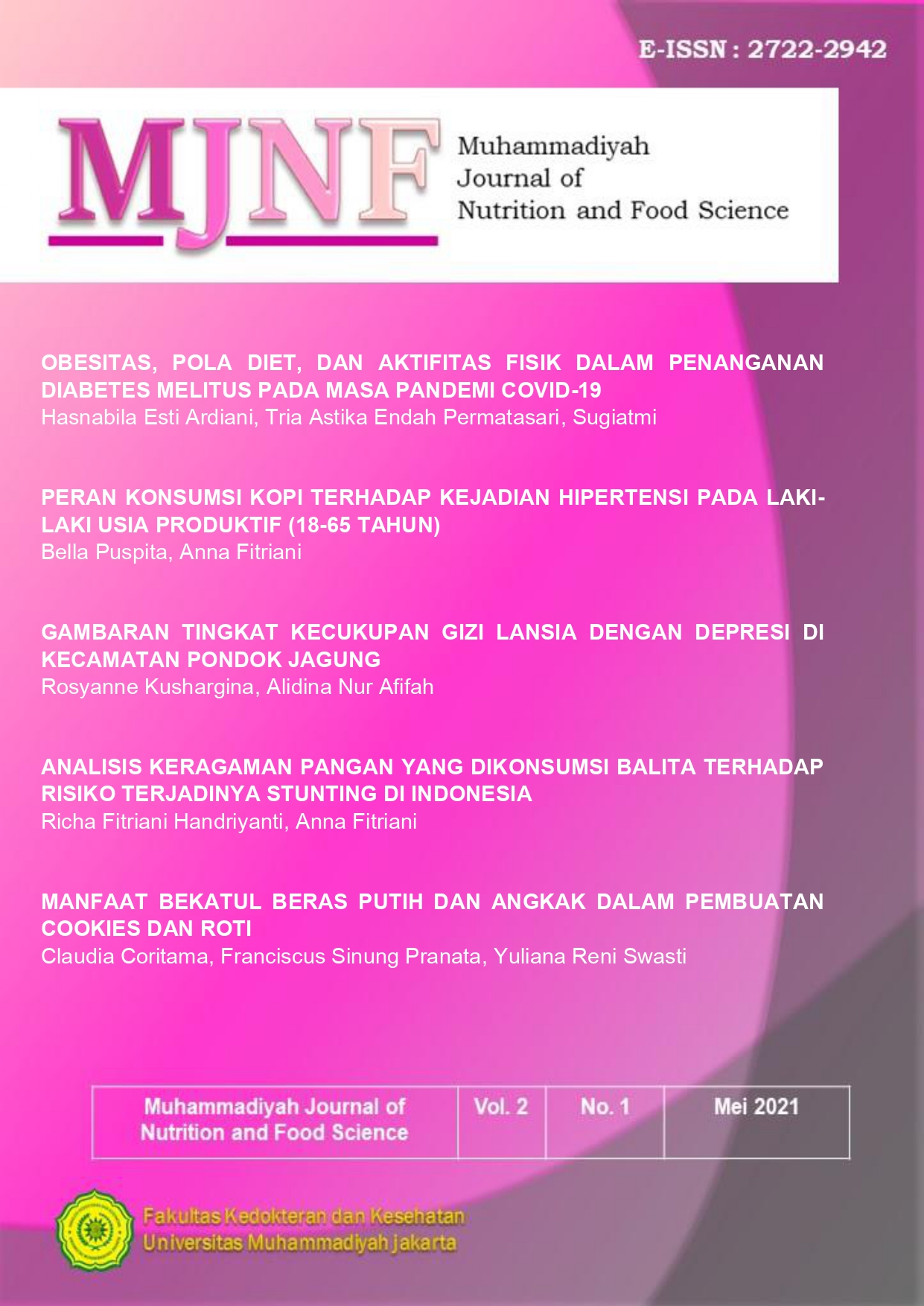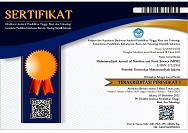Manfaat Bekatul Beras Putih dan Angkak dalam Pembuatan Cookies dan Roti
DOI:
https://doi.org/10.24853/mjnf.2.1.43-57Keywords:
angkak, bekatul beras putih, cookies, rotiAbstract
Latar belakang: Penambahan bahan pada suatu produk pangan seringkali dilakukan untuk meningkatkan kualitas produk tersebut. Ringkasan ini dibuat dengan analisa berbagai sumber penelitian yang telah ada berdasarkan kriteria yang ditetapkan, dan bertujuan untuk mengkaji potensi bekatul beras putih dan angkak untuk meningkatkan kualitas cookies dan roti. Bekatul beras putih merupakan produk samping penggilingan beras yang saat ini banyak diteliti dan dimanfaatkan untuk meningkatkan nilai gizi suatu produk makanan. Angkak merupakan hasil fermentasi beras oleh kapang Monascus purpureus yang selama ini banyak dimanfaatkan sebagai pewarna makanan alami dan obat herbal. Hasil: Penelitian telah membuktikan bahwa bekatul beras putih dapat meningkatkan kadar serat dan antioksidan pada produk bakery, sementara angkak memiliki kemampuan menurunkan kolesterol dan memiliki pigmen warna yang dapat mempengaruhi penampilan cookies dan roti. Potensi tersebut diikuti dengan kekhawatiran yang muncul mengenai isu keamanan pangan pada angkak. Kesimpulan: Bekatul beras putih dan angkak dapat ditambahkan dalam pembuatan cookies dan roti untuk memberikan peningkatan pada parameter fisik dan kimia. Angkak dapat ditambahkan pada produk pangan tanpa diikuti efek samping apabila ditambahkan pada dosis yang normal, serta dapat dilakukan upaya pemanasan untuk mendetoksifikasi citrinin.References
Naim HJN. Pemanfaatan Bekatul sebagai Media Alternatif untuk Pertumbuhan Aspergillus sp. Media Anal Kesehat. 2016;VII(2):1–6.
Mishra N. Utilization of waste defatted rice bran in formulation of functional cookies and its effect on physiochemical characteristic of cookies. Int J Adv Sci Res [Internet]. 2017;2(5):64–8. Available from: http://www.allsciencejournal.com/archives/2017/vol2/issue5/2-5-25
Gul K, Yousuf B, Singh AK, Singh P, Wani AA. Rice bran: Nutritional values and its emerging potential for development of functional food—A review. Bioact Carbohydrates Diet Fibre [Internet]. 2015;6(1):24–30. Available from: https://www.sciencedirect.com/science/article/pii/S2212619815300024
Irakli M, Katsantonis D, Kleisiaris F. Evaluation of quality attributes, nutraceutical components and antioxidant potential of wheat bread substituted with rice bran. J Cereal Sci [Internet]. 2015;65:74–80. Available from: http://europepmc.org/abstract/AGR/IND605426479
Indriati N, Andayani F. Pemanfaatan Angkak Sebagai Pewarna Alami Pada Terasi Udang. J Pascapanen dan Bioteknol Kelaut dan Perikan [Internet]. 2012 Jun 14;7(1):11. Available from: http://www.bbp4b.litbang.kkp.go.id/jurnal-jpbkp/index.php/jpbkp/article/view/65
Trisnawati CY, Srianta I, Nugerahani I, Marsono Y. Incorporating Monascus-fermented durian seeds and rice bran into bread: study on the bread physicochemical and sensory properties. Food Res. 2018 Nov 7;3:280–4.
Wahyuningrum I, Zubaidah E. Pengaruh Angkak dengan Penambahan Bekatul Terhadap Penurunan Profil Lipid Tikus Wistar Jantan Hiperkolesterolemia. J Pangan dan Agroindustri. 2016;4(1):127–36.
Timotius K. Produksi pigmen angkak oleh Monascus. J Teknol dan Ind Pangan. 2004;15(1):79–86.
Žilić S, Kocadağlı T, Vančetović J, Gökmen V. Effects of baking conditions and dough formulations on phenolic compound stability, antioxidant capacity and color of cookies made from anthocyanin-rich corn flour. LWT - Food Sci Technol [Internet]. 2016 Jan;65:597–603. Available from: https://linkinghub.elsevier.com/retrieve/pii/S0023643815301511
Javaria S. Formulation and quality evaluation of aglutenics biscuits supplimented with rice bran for coeliac patients. Pure Appl Biol [Internet]. 2017 Dec 10;6(4). Available from: http://www.thepab.org/files/2017/December-2017/PAB-MS-1702040.pdf
Fuller S, Beck E, Salman H, Tapsell L. New Horizons for the Study of Dietary Fiber and Health: A Review. Plant Foods Hum Nutr. 2016 Mar;71(1):1–12.
Astawan Andi Early MF. Potensi Dedak dan Bekatul Beras Sebagai Ingredient Pangan dan Produk Pangan Fungsional. J PANGAN [Internet]. 2010;(Vol 19, No 1 (2010): PANGAN):14–21. Available from: http://www.jurnalpangan.com/index.php/pangan/article/view/104
Park H-Y, Lee K-W, Choi H-D. Rice bran constituents: immunomodulatory and therapeutic activities. Food Funct. 2017 Mar;8(3):935–43.
Anderson JW, Baird P, Davis RHJ, Ferreri S, Knudtson M, Koraym A, et al. Health benefits of dietary fiber. Nutr Rev. 2009 Apr;67(4):188–205.
Issara U, Rawdkuen S. Rice bran: A potential of main ingredient in healthy beverage. Int Food Res J. 2016 Dec 1;23:2306–18.
Rosniyana A, Hashifah MA, Norin S. The physico-chemical properties and nutritional composition of rice bran produced at different milling degrees of rice (. In 2007.
Kurniati Y, Budijanto S, Nuraida L, Nur F, Dewi A, 085730953088 T: Peningkatan Senyawa Fenolik Bekatul dengan SSF (Solid State Fermentation) sebagai Pencegah Kanker Enhancement of Phenolic Compounds of Rice Bran with SSF (Solid State Fermentation) for Preventing Cancer. Iptek Tanam Pangan [Internet]. 2017;12(2):97–104. Available from: http://ejurnal.litbang.pertanian.go.id/index.php/ippan/article/view/8175
Nugrahawati T. Kajian Karakteristik Mie Kering dengan Substitusi Bekatul. Universitas Sebelas Maret; 2011.
Laokuldilok T, Shoemaker CF, Jongkaewwattana S, Tulyathan V. Antioxidants and antioxidant activity of several pigmented rice brans. J Agric Food Chem. 2011 Jan;59(1):193–9.
Hartati S, Marsono Y, Suparmo S, Santoso U. Komposisi Kimia Serta Aktivitas Antioksidan Ekstrak Hidrofilik Bekatul Beberapa Varietas Padi. J Agritech [Internet]. 2015 May 4;35(01):35. Available from: https://jurnal.ugm.ac.id/agritech/article/view/9417
Oliveira MDS, Feddern V, Kupski L, Cipolatti EP, Badiale-Furlong E, de Souza-Soares LA. Changes in lipid, fatty acids and phospholipids composition of whole rice bran after solid-state fungal fermentation. Bioresour Technol. 2011 Sep;102(17):8335–8.
Jolfaie NR, Rouhani MH, Surkan PJ, Siassi F, Azadbakht L. Rice Bran Oil Decreases Total and LDL Cholesterol in Humans: A Systematic Review and Meta-Analysis of Randomized Controlled Clinical Trials. Horm Metab Res = Horm und Stoffwechselforsch = Horm Metab. 2016 Jul;48(7):417–26.
Orthoefer F. Rice Bran Oil. In: Shahidi F, editor. Bailey’s Industrial Oil and Fat Products. Seventh. John Wiley & Sons, Ltd; 2020.
Irakli M, Lazaridou A, Biliaderis CG. Comparative Evaluation of the Nutritional, Antinutritional, Functional, and Bioactivity Attributes of Rice Bran Stabilized by Different Heat Treatments. Vol. 10, Foods . 2021.
Khan SH, Butt M, Anjum F, Jamil A. Antinutritional Appraisal and Protein Extraction from Differently Stabilized Rice Bran. Pakistan J Nutr. 2009 Aug 1;8.
Bhaskaragoud G, Rajath S, Mahendra VP, Kumar GS, Gopala Krishna AG, Kumar GS. Hypolipidemic mechanism of oryzanol components- ferulic acid and phytosterols. Biochem Biophys Res Commun. 2016 Jul;476(2):82–9.
Perez-Ternero C, Alvarez de Sotomayor M, Herrera MD. Contribution of ferulic acid, γ-oryzanol and tocotrienols to the cardiometabolic protective effects of rice bran. J Funct Foods [Internet]. 2017;32:58–71. Available from: https://www.sciencedirect.com/science/article/pii/S1756464617300865
Yılmaz N, Tuncel NB, Kocabıyık H. Infrared stabilization of rice bran and its effects on γ-oryzanol content, tocopherols and fatty acid composition. J Sci Food Agric. 2014 Jun;94(8):1568–76.
Shafi M, Baba WN, Masoodi FA, Bazaz R. Wheat-water chestnut flour blends: effect of baking on antioxidant properties of cookies. J Food Sci Technol [Internet]. 2016/12/17. 2016 Dec;53(12):4278–88. Available from: https://pubmed.ncbi.nlm.nih.gov/28115768
Echavarría Vélez AP, Pagán J, Ibarz A. Melanoidins Formed by Maillard Reaction in Food and Their Biological Activity. Food Eng Rev. 2012 Dec 1;4:203–23.
Nooshkam M, Varidi M, Bashash M. The Maillard reaction products as food-born antioxidant and antibrowning agents in model and real food systems. Food Chem [Internet]. 2019;275:644–60. Available from: http://europepmc.org/abstract/MED/30724245
Jan U, Gani A, Ahmad M, Shah U, Baba WN, Masoodi FA, et al. Characterization of cookies made from wheat flour blended with buckwheat flour and effect on antioxidant properties. J Food Sci Technol. 2015 Oct;52(10):6334–44.
Bhosale S, Vijayalakshmi D. Processing and Nutritional Composition of Rice Bran. Curr Res Nutr Food Sci J [Internet]. 2015 Apr 30;3(1):74–80. Available from: http://www.foodandnutritionjournal.org/volume3number1/processing-and-nutritional-composition-of-rice-bran/
Oliveira MG de C, Bassinello PZ, Lobo VL da S, Rinaldi MM. Stability and microbiological quality of rice bran subjected to different heat treatments. Food Sci Technol [Internet]. 2012 Aug 23;32(4):725–33. Available from: http://www.scielo.br/scielo.php?script=sci_arttext&pid=S0101-20612012000400014&lng=en&tlng=en
Patil S, Kar A, Mohapatra D. Stabilization of Rice Bran using Microwave: Process Optimization and Storage Studies. Food Bioprod Process. 2016 May 1;99.
Kim S-M, Chung H-J, Lim S-T. Effect of various heat treatments on rancidity and some bioactive compounds of rice bran. J Cereal Sci [Internet]. 2014 Jul;60(1):243–8. Available from: https://linkinghub.elsevier.com/retrieve/pii/S0733521014000782
Loypimai P, Moonggarm A, Chottanom P. Effects of ohmic heating on lipase activity, bioactive compounds and antioxidant activity of rice bran. Aust J Basic Appl Sci. 2009;3(4):3642–52.
Nguyen T, Karl M, Santini A. Red Yeast Rice. Foods. 2017 Mar 1;6:19.
Patel S. Functional food red yeast rice (RYR) for metabolic syndrome amelioration: a review on pros and cons. World J Microbiol Biotechnol. 2016 May;32(5):87.
Mapari SAS, Thrane U, Meyer AS. Fungal polyketide azaphilone pigments as future natural food colorants? Trends Biotechnol. 2010 Jun;28(6):300–7.
Wahid AR, Damayanti A, Wardani AK. Uji Aktivitas Antikolesterol Hasil Fermentasi Angkak pada Tikus Galur Sprague Dawley. J Insa Farm Indones [Internet]. 2019 Dec 28;2(2):250–60. Available from: http://jiis.akfar-isfibjm.ac.id/index.php?journal=JIFI&page=article&op=view&path%5B%5D=296
Asben A, Kasim A. Studi Lama Fermentasi dan Tingkat Kadar Air dalam Produksi Pigmen Angkak pada Substrat Ampas Sagu-Tepung Beras Menggunakan Monascus purpureus. Food Nutr Sci [Internet]. 2015;(September):185–91. Available from: http://www.scirp.org/journal/doi.aspx?DOI=10.4236/fns.2011.28115
Wanti S, Andriani MA., Herriyadi N. Pengaruh Berbagai Jenis Beras Terhadap Aktivitas Antimikrobia Pada Angkak Oleh Monascus purpureus. Biiofarmasi. 2015;13(1):1–5.
Wiyoto H, Andriani MA, Parnanto NHR. Study of antioxidant activity and anti-cholesterol content on red yeast rice with substrates variation (rice, corn and dried cassava). Biofarmasi J Nat Prod Biochem [Internet]. 2011 Aug 17;9(2):38–44. Available from: https://smujo.id/jnpb/article/view/1905
Danuri H. Optimizing Angkak Pigments and Lovastatin Production By Monascus purpureus. Hayati J Biosci [Internet]. 2008 Jun;15(2):61–6. Available from: https://linkinghub.elsevier.com/retrieve/pii/S1978301916302698
Zubaidah E, Dewi A. Effect Addition of Rice Bran on Fermentation Process to Increasing Lovastatin and Intensity of Red Pigment Angkak. Adv J Food Sci Technol. 2014 Jan 10;6:56–9.
Shaik R, Kuna A, Azam M, Tilathoo R, Kanuri M, Samala G. Effect of rice bran oil spread on the physical, sensory and fatty acid profile of cake. J Food Sci Technol [Internet]. 2017/05/16. 2017 Jun;54(7):2126–34. Available from: https://pubmed.ncbi.nlm.nih.gov/28720970
Atma Y, Trilogi U, Trilogi K. Studi Penggunaan Angkak sebagai Pewarna Alami dalam Pengolahan Sosis Daging Sapi. J Teknol. 2015;7(2):2015.
Afdhal M, Lukman H, Indriyani I. Potensi Angkak sebagai Pewarna Alami Terhadap Karakteristik Kornet Daging Ayam. J Ilm Ilmu Terap Univ Jambi [Internet]. 2017 Dec 14;1(2):154–61. Available from: https://online-journal.unja.ac.id/index.php/JIITUJ/article/view/4277
Anam C, Handayani S. Mi Kering Waluh (Cucurbita moschata) dengan Antioksidan dan Pewarna Alami. Caraka Tani J Sustain Agric. 2010;25(1):72.
Murdopo. Kadar Serat Pangan dan Sifat Organoleptik Cookies dengan Penambahan Tepung Biji Kluwih (Antocarpus communis) dan Angkak Sebagai Pewarna Alami. Universitas Muhammadiyah Surakarta; 2014.
Ou H-P, Wang C-CR, Lai L-S. Thermal degradation kinetics analysis of monacolin K in Monascus-fermented products. LWT - Food Sci Technol [Internet]. 2009 Jan;42(1):292–6. Available from: https://linkinghub.elsevier.com/retrieve/pii/S0023643808001412
Asben A, Murtius WS, Rifka A. Antioxidant Activity and Lovastatin Content in Garaetteok (Korean Rice Cake) with Angkak Powder as Food Colouring. IOP Conf Ser Earth Environ Sci [Internet]. 2020 Jun 23;515:012048. Available from: https://iopscience.iop.org/article/10.1088/1755-1315/515/1/012048
Triana E, Yulinery T. Uji toksisitas citrinin yang dihasilkan oleh angkak hasil fermentasi berbagai isolat Monascus purpureus terhadap larva Artemia salina Leach. In: Prosiding Seminar Nasional Masyarakat Biodiversitas Indonesia. 2015. p. 283–8.
Doughari J. The Occurrence, Properties and Significance of Citrinin Mycotoxin. J Plant Pathol Microbiol [Internet]. 2015;6(11). Available from: https://www.omicsonline.org/open-access/the-occurrence-properties-and-significance-of-citrinin-mycotoxin-2157-7471-1000321.php?aid=65382
Wang W, Liao Y, Zhang B, Gao M, Ke W, Li F, et al. Citrinin Monomer and Dimer Derivatives with Antibacterial and Cytotoxic Activities Isolated from the Deep Sea-Derived Fungus Penicillium citrinum NLG-S01-P1. Mar Drugs [Internet]. 2019 Jan 10;17(1):46. Available from: https://pubmed.ncbi.nlm.nih.gov/30634700
Silva LJG, Pereira AMPT, Pena A, Lino CM. Citrinin in foods and supplements: A review of occurrence and analytical methodologies. Foods. 2021;10(1).
Downloads
Published
Issue
Section
License
(c) 2020 MJNF







